Blog & Latest Updates
Fly Fishing Articles
Insects by Common Name


> > The Yakima River
Closeup insects from the Yakima River
Female Baetis tricaudatus (Blue-Winged Olive) Mayfly Nymph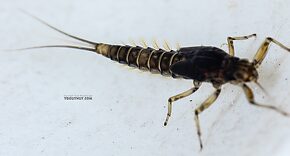 View 13 PicturesThese nymphs were highly abundant in my early April kick net samples from the Yakima Canyon, and one of them emerged into a dun, which I photographed immediately. Similar-looking nymphs but with distinctly brighter color patterns were also abundant. I just photographed one. After extensive views under the microscope, it's clear the bright ones are males and the dull ones are females of the same species.
View 13 PicturesThese nymphs were highly abundant in my early April kick net samples from the Yakima Canyon, and one of them emerged into a dun, which I photographed immediately. Similar-looking nymphs but with distinctly brighter color patterns were also abundant. I just photographed one. After extensive views under the microscope, it's clear the bright ones are males and the dull ones are females of the same species.
The most likely guess at the species is Baetis tricaudatus, which may be a complex of related species that haven't all been sorted out yet. It isn't a perfect fit to every key characteristic (and I never seem to find a Baetis that matches the expected pronotum (Pronotum: The top of the insect prothorax.) color patterns, but that seems to be the closest.
The microscope images here were taken with different specimens from the main photos (so I could dissect them while preserving that one intact), but clearly the same species.
 View 13 PicturesThese nymphs were highly abundant in my early April kick net samples from the Yakima Canyon, and one of them emerged into a dun, which I photographed immediately. Similar-looking nymphs but with distinctly brighter color patterns were also abundant. I just photographed one. After extensive views under the microscope, it's clear the bright ones are males and the dull ones are females of the same species.
View 13 PicturesThese nymphs were highly abundant in my early April kick net samples from the Yakima Canyon, and one of them emerged into a dun, which I photographed immediately. Similar-looking nymphs but with distinctly brighter color patterns were also abundant. I just photographed one. After extensive views under the microscope, it's clear the bright ones are males and the dull ones are females of the same species. The most likely guess at the species is Baetis tricaudatus, which may be a complex of related species that haven't all been sorted out yet. It isn't a perfect fit to every key characteristic (and I never seem to find a Baetis that matches the expected pronotum (Pronotum: The top of the insect prothorax.) color patterns, but that seems to be the closest.
The microscope images here were taken with different specimens from the main photos (so I could dissect them while preserving that one intact), but clearly the same species.
Collected April 9, 2021 from the Yakima River in Washington
Added to Troutnut.com by Troutnut on April 12, 2021
Added to Troutnut.com by Troutnut on April 12, 2021
Female Baetis tricaudatus (Blue-Winged Olive) Mayfly Dun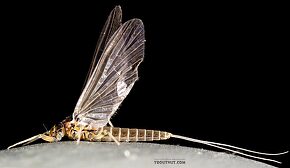 View 9 PicturesThis dun emerged on my desk from a container of nymphs I was sorting, so I was able to get an ID from the nymphs. I also uploaded photos of a female nymph and a male nymph.
View 9 PicturesThis dun emerged on my desk from a container of nymphs I was sorting, so I was able to get an ID from the nymphs. I also uploaded photos of a female nymph and a male nymph.
 View 9 PicturesThis dun emerged on my desk from a container of nymphs I was sorting, so I was able to get an ID from the nymphs. I also uploaded photos of a female nymph and a male nymph.
View 9 PicturesThis dun emerged on my desk from a container of nymphs I was sorting, so I was able to get an ID from the nymphs. I also uploaded photos of a female nymph and a male nymph.Collected April 9, 2021 from the Yakima River in Washington
Added to Troutnut.com by Troutnut on April 11, 2021
Added to Troutnut.com by Troutnut on April 11, 2021
Ephemerella excrucians (Pale Morning Dun) Mayfly Nymph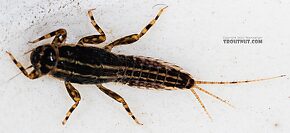 View 10 Pictures
View 10 Pictures
 View 10 Pictures
View 10 PicturesCollected April 9, 2021 from the Yakima River in Washington
Added to Troutnut.com by Troutnut on April 12, 2021
Added to Troutnut.com by Troutnut on April 12, 2021
Helicopsyche borealis (Speckled Peter) Caddisfly Pupa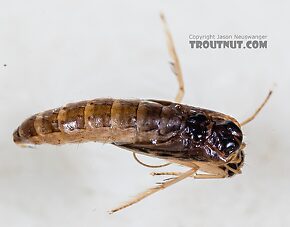 View 13 PicturesI'm calling this one very tentatively Helicopsyche borealis, with some big caveats that I might be wrong.
View 13 PicturesI'm calling this one very tentatively Helicopsyche borealis, with some big caveats that I might be wrong.
It seems to key fairly easily to Helicopsychidae, except at the last couplet in Merritt & Cummins (5th ed) it's supposed to have “anal processes short and straight, each with several mesal (Mesal: Toward the middle.) setae (Seta: Little hairs on insects.) and 2 long apical (Apical: Close to the apex; tip or end.) setae (Seta: Little hairs on insects.),” whereas this one has VERY short, straight processes with 3 long apical (Apical: Close to the apex; tip or end.) setae (Seta: Little hairs on insects.) and no mesal (Mesal: Toward the middle.) ones.
Additionally, the only species of Helicopsychidae documented in this region is Helicopsyche borealis, which is supposed to emerge much later in the summer.
 View 13 PicturesI'm calling this one very tentatively Helicopsyche borealis, with some big caveats that I might be wrong.
View 13 PicturesI'm calling this one very tentatively Helicopsyche borealis, with some big caveats that I might be wrong.It seems to key fairly easily to Helicopsychidae, except at the last couplet in Merritt & Cummins (5th ed) it's supposed to have “anal processes short and straight, each with several mesal (Mesal: Toward the middle.) setae (Seta: Little hairs on insects.) and 2 long apical (Apical: Close to the apex; tip or end.) setae (Seta: Little hairs on insects.),” whereas this one has VERY short, straight processes with 3 long apical (Apical: Close to the apex; tip or end.) setae (Seta: Little hairs on insects.) and no mesal (Mesal: Toward the middle.) ones.
Additionally, the only species of Helicopsychidae documented in this region is Helicopsyche borealis, which is supposed to emerge much later in the summer.
Collected April 9, 2021 from the Yakima River in Washington
Added to Troutnut.com by Troutnut on April 12, 2021
Added to Troutnut.com by Troutnut on April 12, 2021
Ephemerella excrucians (Pale Morning Dun) Mayfly Nymph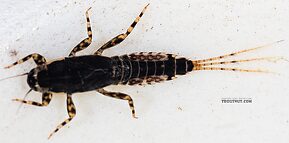 View 9 Pictures
View 9 Pictures
 View 9 Pictures
View 9 PicturesCollected April 9, 2021 from the Yakima River in Washington
Added to Troutnut.com by Troutnut on April 12, 2021
Added to Troutnut.com by Troutnut on April 12, 2021
Pteronarcys californica (Giant Salmonfly) Stonefly Nymph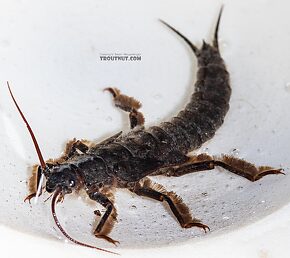 View 5 PicturesThis salmonfly nymph is probably not quite fully grown, as it still has a couple months yet to emerge.
View 5 PicturesThis salmonfly nymph is probably not quite fully grown, as it still has a couple months yet to emerge.
 View 5 PicturesThis salmonfly nymph is probably not quite fully grown, as it still has a couple months yet to emerge.
View 5 PicturesThis salmonfly nymph is probably not quite fully grown, as it still has a couple months yet to emerge.Collected April 9, 2021 from the Yakima River in Washington
Added to Troutnut.com by Troutnut on April 12, 2021
Added to Troutnut.com by Troutnut on April 12, 2021
Ameletus vernalis (Brown Dun) Mayfly Nymph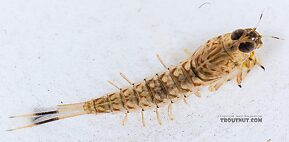 View 9 PicturesI keyed this one out using the Alberta species key from Zloty & Pritchard 1997.
View 9 PicturesI keyed this one out using the Alberta species key from Zloty & Pritchard 1997.
Notes from the ID include:
1. Posterior (Posterior: Toward the back of an organism's body. The phrase "posterior to" means "in back of.") margin of sternites (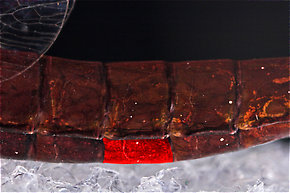 Sternite: The bottom (ventral) part of a single segment on an insect's abdomen.) 6-8 without spines
Sternite: The bottom (ventral) part of a single segment on an insect's abdomen.) 6-8 without spines
2. Mesal (Mesal: Toward the middle.) gill extension "well developed"
3. Basil third of caudal (Caudal: Toward the posterior tip of the body.) filaments pale
4. Anterior (Anterior: Toward the front of an organism's body. The phrase "anterior to" means "in front of.") surface of front femora (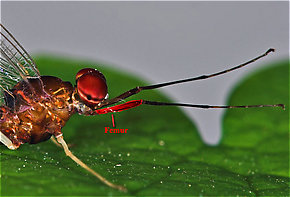 Femur: The main segment of an insect's leg close to the body, in between the tibia and the trochanter.) mostly pale
Femur: The main segment of an insect's leg close to the body, in between the tibia and the trochanter.) mostly pale
5. Dark band on caudal (Caudal: Toward the posterior tip of the body.) filaments begins around segment 20
6. Final instars (Instar: Many invertebrates molt through dozens of progressively larger and better-developed stages as they grow. Each of these stages is known as an instar. Hard-bodied nymphs typically molt through more instars than soft-bodied larvae.) early season
This one keys out pretty cleanly to Ameletus vernalis except the color pattern on the tergites (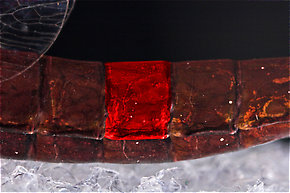 Tergite: The top (dorsal) part of a single segment on an insect's abdomen when it consists of a single chitinous plate (sclerite), or an individual sclerite if the segment has more than one.) doesn't match. However, two species known in Washington aren't included in the key. Of those two, Ameletus vancouverensis would be too small (adult body length 9 mm), but Ameletus andersoni (currently documented only from a spring in Cowlitz County) has a wide range of sizes and emergence times that could be compatible with this one. So I can't rule that species out, but Ameletus vernalis seems the most likely.
Tergite: The top (dorsal) part of a single segment on an insect's abdomen when it consists of a single chitinous plate (sclerite), or an individual sclerite if the segment has more than one.) doesn't match. However, two species known in Washington aren't included in the key. Of those two, Ameletus vancouverensis would be too small (adult body length 9 mm), but Ameletus andersoni (currently documented only from a spring in Cowlitz County) has a wide range of sizes and emergence times that could be compatible with this one. So I can't rule that species out, but Ameletus vernalis seems the most likely.
 View 9 PicturesI keyed this one out using the Alberta species key from Zloty & Pritchard 1997.
View 9 PicturesI keyed this one out using the Alberta species key from Zloty & Pritchard 1997. Notes from the ID include:
1. Posterior (Posterior: Toward the back of an organism's body. The phrase "posterior to" means "in back of.") margin of sternites (

One sternite of this Isonychia bicolor mayfly spinner is highlighted in red.
2. Mesal (Mesal: Toward the middle.) gill extension "well developed"
3. Basil third of caudal (Caudal: Toward the posterior tip of the body.) filaments pale
4. Anterior (Anterior: Toward the front of an organism's body. The phrase "anterior to" means "in front of.") surface of front femora (

The femur of this Isonychia bicolor mayfly spinner is highlighted in red.
5. Dark band on caudal (Caudal: Toward the posterior tip of the body.) filaments begins around segment 20
6. Final instars (Instar: Many invertebrates molt through dozens of progressively larger and better-developed stages as they grow. Each of these stages is known as an instar. Hard-bodied nymphs typically molt through more instars than soft-bodied larvae.) early season
This one keys out pretty cleanly to Ameletus vernalis except the color pattern on the tergites (

One tergite of this Isonychia bicolor mayfly spinner is highlighted in red.
Collected April 9, 2021 from the Yakima River in Washington
Added to Troutnut.com by Troutnut on April 12, 2021
Added to Troutnut.com by Troutnut on April 12, 2021
Female Isoperla fusca (Yellow Sally) Stonefly Adult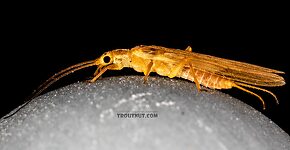 View 13 PicturesThe family ID on this one was a little bit tricky. Just going by the size, shape, and color, it looks like Chloroperlidae. However, the second anal vein of the forewing is does not appear to be forked, and the apical (Apical: Close to the apex; tip or end.) maxillary palpal segment is close to the length of the penultimate segment, both of which rule out that family. The position of the cubitoanal crossvein (Crossvein: Short cross-wise veins in an insect wing which connect the long longitudinal (length-wise) veins.) relative to the anal cell in the forewing -- touching it in this case -- indicates Perlidae (and it really doesn't have the "look" of Perlidae at all), but other characteristics, such as the metathorastic sternacostal sutures and lack of gill remnants, point to Perlodidae. That's the right answer. Moving on to Perlodidae, the key characteristics in Merritt & Cummins lead straightforwarly to Isoperla, and the species key in Jewett 1959 (The Stoneflies of the Pacific Northwest) leads to Isoperla fusca.
View 13 PicturesThe family ID on this one was a little bit tricky. Just going by the size, shape, and color, it looks like Chloroperlidae. However, the second anal vein of the forewing is does not appear to be forked, and the apical (Apical: Close to the apex; tip or end.) maxillary palpal segment is close to the length of the penultimate segment, both of which rule out that family. The position of the cubitoanal crossvein (Crossvein: Short cross-wise veins in an insect wing which connect the long longitudinal (length-wise) veins.) relative to the anal cell in the forewing -- touching it in this case -- indicates Perlidae (and it really doesn't have the "look" of Perlidae at all), but other characteristics, such as the metathorastic sternacostal sutures and lack of gill remnants, point to Perlodidae. That's the right answer. Moving on to Perlodidae, the key characteristics in Merritt & Cummins lead straightforwarly to Isoperla, and the species key in Jewett 1959 (The Stoneflies of the Pacific Northwest) leads to Isoperla fusca.
There is one caveat: That source does suggest a May-July emergence, whereas this one was collected in mid-September.
 View 13 PicturesThe family ID on this one was a little bit tricky. Just going by the size, shape, and color, it looks like Chloroperlidae. However, the second anal vein of the forewing is does not appear to be forked, and the apical (Apical: Close to the apex; tip or end.) maxillary palpal segment is close to the length of the penultimate segment, both of which rule out that family. The position of the cubitoanal crossvein (Crossvein: Short cross-wise veins in an insect wing which connect the long longitudinal (length-wise) veins.) relative to the anal cell in the forewing -- touching it in this case -- indicates Perlidae (and it really doesn't have the "look" of Perlidae at all), but other characteristics, such as the metathorastic sternacostal sutures and lack of gill remnants, point to Perlodidae. That's the right answer. Moving on to Perlodidae, the key characteristics in Merritt & Cummins lead straightforwarly to Isoperla, and the species key in Jewett 1959 (The Stoneflies of the Pacific Northwest) leads to Isoperla fusca.
View 13 PicturesThe family ID on this one was a little bit tricky. Just going by the size, shape, and color, it looks like Chloroperlidae. However, the second anal vein of the forewing is does not appear to be forked, and the apical (Apical: Close to the apex; tip or end.) maxillary palpal segment is close to the length of the penultimate segment, both of which rule out that family. The position of the cubitoanal crossvein (Crossvein: Short cross-wise veins in an insect wing which connect the long longitudinal (length-wise) veins.) relative to the anal cell in the forewing -- touching it in this case -- indicates Perlidae (and it really doesn't have the "look" of Perlidae at all), but other characteristics, such as the metathorastic sternacostal sutures and lack of gill remnants, point to Perlodidae. That's the right answer. Moving on to Perlodidae, the key characteristics in Merritt & Cummins lead straightforwarly to Isoperla, and the species key in Jewett 1959 (The Stoneflies of the Pacific Northwest) leads to Isoperla fusca. There is one caveat: That source does suggest a May-July emergence, whereas this one was collected in mid-September.
Collected September 17, 2020 from the Yakima River in Washington
Added to Troutnut.com by Troutnut on September 19, 2020
Added to Troutnut.com by Troutnut on September 19, 2020
Male Acentrella insignificans (Tiny Blue-Winged Olive) Mayfly Dun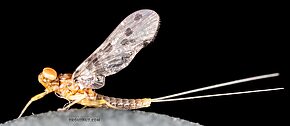 View 11 PicturesThis specimen emerged indoors from nymphs I had collected, then partly molted into a spinner but got stuck along the way. I've included a couple pictures showing some of the spinner colors. It got a bit waterlogged after emerging, so the wings aren't in perfect shape, but it still represents one of two Baetids that were emerging and drawing trout to rise on the Yakima. Based on body size and shape, it is most likely the same species as this nymph.
View 11 PicturesThis specimen emerged indoors from nymphs I had collected, then partly molted into a spinner but got stuck along the way. I've included a couple pictures showing some of the spinner colors. It got a bit waterlogged after emerging, so the wings aren't in perfect shape, but it still represents one of two Baetids that were emerging and drawing trout to rise on the Yakima. Based on body size and shape, it is most likely the same species as this nymph.
 View 11 PicturesThis specimen emerged indoors from nymphs I had collected, then partly molted into a spinner but got stuck along the way. I've included a couple pictures showing some of the spinner colors. It got a bit waterlogged after emerging, so the wings aren't in perfect shape, but it still represents one of two Baetids that were emerging and drawing trout to rise on the Yakima. Based on body size and shape, it is most likely the same species as this nymph.
View 11 PicturesThis specimen emerged indoors from nymphs I had collected, then partly molted into a spinner but got stuck along the way. I've included a couple pictures showing some of the spinner colors. It got a bit waterlogged after emerging, so the wings aren't in perfect shape, but it still represents one of two Baetids that were emerging and drawing trout to rise on the Yakima. Based on body size and shape, it is most likely the same species as this nymph.Collected September 12, 2020 from the Yakima River in Washington
Added to Troutnut.com by Troutnut on September 19, 2020
Added to Troutnut.com by Troutnut on September 19, 2020
Baetis tricaudatus (Blue-Winged Olive) Mayfly Nymph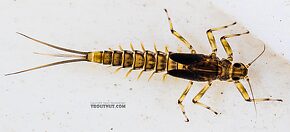 View 20 PicturesA nymph of the same species as this one emerged into a dun in my studio so I got photos of both stages.
View 20 PicturesA nymph of the same species as this one emerged into a dun in my studio so I got photos of both stages.
NOTE: I missed an important key characteristic the first time I tried to identify this one (robust setae (Seta: Little hairs on insects.) on the abdominal sternites ( Sternite: The bottom (ventral) part of a single segment on an insect's abdomen.), which were harder to see than I expected but are clearly present), so I went on a bit of a wild goose chase and landed at a dead end. After spotting that characteristic, this one keys more straightforwardly to either Baetis tricaudatus or the Baetis piscatoris complex. It doesn't seem to be a perfect fit for either one in the key, but I'm going with tricaudatus based on range and abundance. It's not certain.
Sternite: The bottom (ventral) part of a single segment on an insect's abdomen.), which were harder to see than I expected but are clearly present), so I went on a bit of a wild goose chase and landed at a dead end. After spotting that characteristic, this one keys more straightforwardly to either Baetis tricaudatus or the Baetis piscatoris complex. It doesn't seem to be a perfect fit for either one in the key, but I'm going with tricaudatus based on range and abundance. It's not certain.
However, I'm leaving the flawed analysis below with this disclaimer, because some aspects of how I approached that dead end might be informative in the future.
----Incorrect analysis below----
After spending a lot of time with this one under my shiny new microscope, I'm still not quite sure what it is. I botched my attempt to expose the mouth parts that might make the ID more definitive. Based on the key in Webb et al 2018's "Baetis Larvae of North America," here's my reasoning at each key couplet.
Couplet 1. The pronotum (Pronotum: The top of the insect prothorax.) lacks dark, submedian U-shaped markings. Also, if I were to follow through to couplet 2, there seem to be characteristics that rule out each of the options: the intercalaris complex is ruled out by the abdominal markings, and the caudal (Caudal: Toward the posterior tip of the body.) filaments have neither a dark median band (ruling out the flavistriga complex) nor uniform pale coloration (ruling out Baetis notos). This sends me with decent confidence to couplet 4.
Couplet 4. I cannot find robust setae (Seta: Little hairs on insects.) in my microscope on the scapes, pedicels, paraprocts, or sterna. I also do not see a pair of dark, bilobed markings on the pronotum (Pronotum: The top of the insect prothorax.). Unless I overlooked these characteristics, proceed to couplet 9.
Couplet 9. Abdominal tergum (Tergum: the dorsal part of an abdominal segment or segments (terga). Also used to describe the entire abdominal dorsum or the thoracic dorsal segments of Odonata.) 5 is a bit paler than adjacent terga (Tergum: the dorsal part of an abdominal segment or segments (terga). Also used to describe the entire abdominal dorsum or the thoracic dorsal segments of Odonata.), but "distinctly paler"? The figure for Baetis alius in the paper, as well as a very nice picture posted by Millcreek in the forum here, shows that Baetis alius would have darker tergites ( Tergite: The top (dorsal) part of a single segment on an insect's abdomen when it consists of a single chitinous plate (sclerite), or an individual sclerite if the segment has more than one.) surrounding #5. So proceed to couplet 11.
Tergite: The top (dorsal) part of a single segment on an insect's abdomen when it consists of a single chitinous plate (sclerite), or an individual sclerite if the segment has more than one.) surrounding #5. So proceed to couplet 11.
Couplet 11. The length of the gills is obviously less than 2X their width. This leads to the Baetis vernus complex, which could include that species or Baetis brunneicolor. This key doesn't say how to tell those species apart.
Switching over to Burien et al 2018 as the source, the characteristics used to distinguish vernus from brunneicolor seem to rule out either one. Brunneicolor should have more uniformly brown abdominal tergites ( Tergite: The top (dorsal) part of a single segment on an insect's abdomen when it consists of a single chitinous plate (sclerite), or an individual sclerite if the segment has more than one.), whereas vernus should have a lack of visible tracheation in most of the gills.
Tergite: The top (dorsal) part of a single segment on an insect's abdomen when it consists of a single chitinous plate (sclerite), or an individual sclerite if the segment has more than one.), whereas vernus should have a lack of visible tracheation in most of the gills.
The fore femur ( Femur: The main segment of an insect's leg close to the body, in between the tibia and the trochanter.) length is about 3.8x its width.
Femur: The main segment of an insect's leg close to the body, in between the tibia and the trochanter.) length is about 3.8x its width.
Also worth noting: In the genus ID, I thought I could see the villipore in my microscope, but I'm not sure. If I back out of Baetis altogether and assume there's no villipore, I end up at Fallceon, but this specimen doesn't seem to have the frontal keel on the head that's supposed to be present on Fallceon quilleri. So that seems like a dead end as well.
 View 20 PicturesA nymph of the same species as this one emerged into a dun in my studio so I got photos of both stages.
View 20 PicturesA nymph of the same species as this one emerged into a dun in my studio so I got photos of both stages.NOTE: I missed an important key characteristic the first time I tried to identify this one (robust setae (Seta: Little hairs on insects.) on the abdominal sternites (

One sternite of this Isonychia bicolor mayfly spinner is highlighted in red.
However, I'm leaving the flawed analysis below with this disclaimer, because some aspects of how I approached that dead end might be informative in the future.
----Incorrect analysis below----
After spending a lot of time with this one under my shiny new microscope, I'm still not quite sure what it is. I botched my attempt to expose the mouth parts that might make the ID more definitive. Based on the key in Webb et al 2018's "Baetis Larvae of North America," here's my reasoning at each key couplet.
Couplet 1. The pronotum (Pronotum: The top of the insect prothorax.) lacks dark, submedian U-shaped markings. Also, if I were to follow through to couplet 2, there seem to be characteristics that rule out each of the options: the intercalaris complex is ruled out by the abdominal markings, and the caudal (Caudal: Toward the posterior tip of the body.) filaments have neither a dark median band (ruling out the flavistriga complex) nor uniform pale coloration (ruling out Baetis notos). This sends me with decent confidence to couplet 4.
Couplet 4. I cannot find robust setae (Seta: Little hairs on insects.) in my microscope on the scapes, pedicels, paraprocts, or sterna. I also do not see a pair of dark, bilobed markings on the pronotum (Pronotum: The top of the insect prothorax.). Unless I overlooked these characteristics, proceed to couplet 9.
Couplet 9. Abdominal tergum (Tergum: the dorsal part of an abdominal segment or segments (terga). Also used to describe the entire abdominal dorsum or the thoracic dorsal segments of Odonata.) 5 is a bit paler than adjacent terga (Tergum: the dorsal part of an abdominal segment or segments (terga). Also used to describe the entire abdominal dorsum or the thoracic dorsal segments of Odonata.), but "distinctly paler"? The figure for Baetis alius in the paper, as well as a very nice picture posted by Millcreek in the forum here, shows that Baetis alius would have darker tergites (

One tergite of this Isonychia bicolor mayfly spinner is highlighted in red.
Couplet 11. The length of the gills is obviously less than 2X their width. This leads to the Baetis vernus complex, which could include that species or Baetis brunneicolor. This key doesn't say how to tell those species apart.
Switching over to Burien et al 2018 as the source, the characteristics used to distinguish vernus from brunneicolor seem to rule out either one. Brunneicolor should have more uniformly brown abdominal tergites (

One tergite of this Isonychia bicolor mayfly spinner is highlighted in red.
The fore femur (

The femur of this Isonychia bicolor mayfly spinner is highlighted in red.
Also worth noting: In the genus ID, I thought I could see the villipore in my microscope, but I'm not sure. If I back out of Baetis altogether and assume there's no villipore, I end up at Fallceon, but this specimen doesn't seem to have the frontal keel on the head that's supposed to be present on Fallceon quilleri. So that seems like a dead end as well.
Collected September 12, 2020 from the Yakima River in Washington
Added to Troutnut.com by Troutnut on September 19, 2020
Added to Troutnut.com by Troutnut on September 19, 2020
Start a Discussion of the Yakima River:
Top 10 Fly Hatches
Top Gift Shop Designs
Eat mayflies.
Top Insect Specimens
Miscellaneous Sites
Troutnut.com is copyright © 2004-2024 Jason
Neuswanger (email Jason). See my FAQ for information about use of my images.
 privacy policy
privacy policy
